Covid-19 Live Updates: US Crosses 13 Million Cases, Adding to Fears Over Thanksgiving Travel
As grading returns to pre-pandemic standards, many U.S. students are failing. Much of Europe, though not Germany, begins easing lockdowns before the end-of-year holidays.
https://movienews.substack.com/p/news-covid-19-live-updates-us-crosses
https://sites.google.com/view/covid19-live-update-suscrosses
https://covid19newshome.blogspot.com/2020/11/covid-19-live-updates-us-crosses-13.html
https://www.guest-articles.com/news/updates-covid19-live-us-crosses-13-million-cases-adding-to-fears-over-thanksgiving-travel-27-11-2020
https://www.milesplit.com/discussion/171466
https://newsfortodays.hatenablog.com/entry/2020/11/28/041946\
https://blog.goo.ne.jp/firsteverythingme/e/91ded47125760ae92f5130504664e5b5
https://dcm.shivtr.com/forum_threads/3274614
https://happyanksgiving.tumblr.com/post/635966506574004224/tyftcfhgdrffgcv
https://www.hybrid-analysis.com/sample/b62a0579c37ecfc7e716c5d3e968cfbab3096fadf5f3e94a67ff41039882e614
https://www.peeranswer.com/question/5fc14f9884917aa9656102a4
https://caribbeanfever.com/photo/albums/rstjdurhyxdgdrfcgdrfgcvdrf
http://officialguccimane.ning.com/profiles/status/show?id=3685062%3AStatus%3A51799342
https://www.posts123.com/post/916705/watch-freaky-2020-full-hd-version-movie
https://www.1upfun.com/link/673071/watch-freaky-2020-full-hd-version-movie
http://www.4mark.net/story/2855560/watch-freaky-(2020)-full-hd-version-movie
https://www.topfind88.com/post/916706/watch-freaky-2020-full-hd-version-movie
https://note.com/sdfgbnerdf/n/n5a5b68d4f3ed
https://friendpaste.com/3exQnMV2RTxJCRiI6185T2
https://slexy.org/view/s2H1ukLZ4q
https://paste.feed-the-beast.com/view/f85f7025
https://jsfiddle.net/zkvycu3r/
https://paiza.io/projects/_jjEb2GWfUSI6_cCksbX1Q
https://onlinegdb.com/cvBpOC2X2
U.S. coronavirus infections shoot past 13 million, even as millions ignore Thanksgiving travel warnings.

General Mitchell International Airport in Milwaukee, Wis., on Wednesday. Despite strong warnings from the C.D.C., millions of Americans opted to travel for the Thanksgiving holiday by plane or by car. Credit…Lauren Justice for The New York Times. Continue reading the main story
The number of coronavirus infections in the United States shot past 13 million on Friday, worsening the world’s largest outbreak. The new record came a day after Americans celebrated Thanksgiving against a backdrop of national travel patterns that, while diminished, still raised the prospect of an even greater rise in infections around the country. Continue reading the main story
Public health experts repeatedly warned Americans to stay in place and not meet up with family and friends during the holiday, and many heeded the advice. But while overall travel within the country was down significantly from prior years, the Transportation Security Administration reported that more than half a million people flew on Thursday alone, in addition to the approximately four million who had already traveled since Sunday. AAA had projected a downturn in road travel, and yet still expected tens of millions of people to drive to celebrations. Continue reading the main story
The U.S. has had one of the world’s highest per capita caseloads in the past week. And every day for more than two weeks, the country has set records for the number of people in the hospital, with the latest figure surging past 90,000 for the first time on Thursday. Continue reading the main story
The latest virus surge began accelerating across much of the country in mid-October. The nation went from eight million cases to nine million in just over two weeks in October; from nine to 10 million in 10 days; from 10 million to 11 million in just under seven days; and from 11 million to 12 million in just five days, hitting that milestone on Nov. 20. The pace to the 13 millionth case slowed, coming after seven days. Continue reading the main story
Public health experts have expressed concern that with the daily death toll already soaring, the nation could only expect harder days to come.
“We certainly expect a surge,” said Dr. William Hanage, a professor of epidemiology at the Harvard T.H. Chan School of Public Health, said in an email on Friday. “Gatherings have been smaller than usual, and so the increase may be less than what would have happened if everything went off as normal. However, we expect more transmission for both the theoretical reason that more contacts were made, and based on prior experience with holidays.” Continue reading the main story
On Thursday, more than 103,000 cases and more than 1,100 deaths were recorded — numbers that were artificially low because many states did not report data on the holiday. For the same reason, the numbers are likely to be artificially high on Friday, when many states will report two days’ worth of data. Where cases per capita are highest. Continue reading the main story
Nursing homes in the U.S. account for roughly 40 percent of Covid-19 fatalities.

The United States’ first wave of Covid-19 deaths in nursing homes started in March at the Life Care Center in Kirkland, Wash.Credit…Grant Hindsley for The New York Times
More than 101,000 people living and working at nursing homes and other long-term care facilities in the United States have died after contracting the coronavirus, a New York Times analysis of federal, state and local data has found, as the country’s daily death toll from the virus has risen above 2,000 Americans in recent days.
Nursing home populations are particularly vulnerable to the virus, which is especially lethal to older adults who have underlying health conditions, and which can spread easily in congregate facilities.
The Times analysis has uncovered more than 724,000 coronavirus cases infecting people at some 27,000 long-term care facilities. Deaths related to Covid-19 in these centers account for about 40 percent of the country’s pandemic fatalities.
The American Health Care Association and National Center for Assisted Living, a trade group, has warned that cases have been surging in long-term care facilities in recent weeks.
Many nursing homes, which have also struggled with the damaging effects of isolation on their residents, have tried to plan special events for Thanksgiving for those who may not be able to see their families.
Julie Beckert, a spokeswoman for ProMedica Senior Care, which operates more than 400 care facilities, said that staff have organized a “turkey trot” through the halls and have asked families and communities to arrange holiday parades outside of their facilities, so residents can watch from the windows.
— Alex Lemonides, Jordan Allen, Alex Leeds Matthews and Barbara Harvey
NURSING HOMES
Read more about the spread of the coronavirus in U.S. nursing homes.
ADVERTISEMENT
Continue reading the main story
In and around Buffalo, N.Y., a second wave hits ‘with a vengeance.’

A line of cars waits at a Covid-19 testing site in Buffalo earlier this month. The city is experiencing a surge in coronavirus cases.Credit…Libby March for The New York Times
Over the past month, the number of coronavirus cases has increased tenfold in the New York city of Buffalo and its surrounding suburbs. Hospitalizations already have surpassed the levels seen in the spring. And the Covid-19 hotline for Erie County, where Buffalo is situated, is getting “annihilated,” the health commissioner said, with 1,500 calls in one 24-hour period this week.
“The second wave is here, and it is here with a vengeance,” Mark Poloncarz, the county executive, said at a news conference, urging residents to take the surge seriously.
Western New York, a bustling five-county region of some 1.4 million people along the Canadian border, has emerged as the biggest trouble spot of the state’s second coronavirus wave. If New York City was the hot spot of the spring, then this area seems to presently have that distinction.
Normally known for its neighborliness, its Buffalo Bills football team and its namesake spicy chicken wings, the region now gets regular criticism from Gov. Andrew M. Cuomo for its average positive test rate, which has remained around 5 percent for two weeks.
The rise in Erie County has been a more extreme version of what is happening statewide, and more so resembles the uptick in other regions of the country. Since mid-October, the number of cases in the county has gone from 322 per week to 3,449 per week. Hospitalizations have risen from 84 on Nov. 10 to 264 on Nov. 23. While hospitals have sufficient beds for now, county officials said, staff is being stretched thin.
Forty people have already died of the virus in November, bringing the total coronavirus fatalities in the county to 779 people, according to a New York Times database.
But, in an encouraging sign, Erie County’s infection rate has leveled off at around 7 percent in the last few days, indicating that some restrictions are having an effect. As the message has gotten through, there are now lines to get coronavirus testing, and masking in public places is generally good, residents said, although there has been some pushback regarding current virus restrictions.
“I do believe the vast majority of people in my community are taking it seriously, whether they live in the city of Buffalo or they’re in a rural community,” Mr. Poloncarz, a Democrat, said in an interview. “But there are some folks who are not. And unfortunately, those individuals put at risk the entire community for further shutdowns.”
— Daniel E. Higgins and Sharon Otterman
BUFFALO OUTBREAK
Read more about the wave of cases in Upstate New York.
‘Unprecedented learning loss’: U.S. students rack up failures as grading returns to pre-pandemic standards.


School districts around the country are reporting more failing grades among students who are distance learning. Angel Medrano, 8, got help with math from his sister Cassandra, 16, while distance learning in Phoenix in October.Credit…John Moore/Getty Images
When the coronavirus forced an abrupt switch to remote learning in the spring, many U.S. school districts made major changes in student report cards — dropping letter grades, guaranteeing A’s or ensuring that performance during the pandemic would not count against students.
That changed this fall. Although some schools continue to be lenient, many others have returned to their normal grading policies. And in at least some large districts, more students are failing than in past years, with the most vulnerable seeing the biggest declines.
In Houston, the nation’s seventh-largest public school district, which started the fall remotely, 42 percent of students failed two or more classes in the first grading period, compared to 11 percent in a normal year, The Houston Chronicle reported.
In Chicago, the nation’s second-largest district, 13 percent of high school students failed math in the fall quarter, compared to 9.5 percent last fall, The Chicago Tribune reported. Students will return to classrooms there in January, according to the city’s current plan.
And in Northside Independent School District in San Antonio, one of the nation’s 30 largest, the share of students failing at least one course in the first grading period increased from 8 percent last year to roughly 25 percent. More than half of students have opted to remain remote, and those students are disproportionately poor, said the superintendent, Brian T. Woods.
“We’re obviously dealing with unprecedented learning loss and course failure,” he said, “and it’s going to take years to mitigate.”
At the Fairfax County Public Schools, the largest district in Virginia and 11th-largest in the country, an internal analysis found that the percentage of middle school and high school students earning F’s in at least two classes had jumped from 6 percent in the first quarter a year ago to 11 percent this year. Fairfax County has brought back only a small fraction of its 188,000 students for in-person instruction.
Already disadvantaged students appear to be faring worse in remote classes, putting them at increased risk of long-term disengagement and dropping out.
Fairfax County found that students who had performed well before the pandemic were still doing well — better than predicted, in fact — while those who had struggled before were doing even worse now. Among students learning English and students with disabilities, the rate of failure had more than doubled.
The district said it had made adjustments to try to help struggling students complete assignments, including allowing schools to offer “catch up” days and setting limits on much homework. But one critic thought the district and teachers needed to change their approach.
“Where’s the grace?” tweeted Melinda D. Anderson, an education journalist, suggesting that teachers needed to adjust their expectations and work differently with students during the pandemic, and that the district should restructure its grading to reflect the “current learning reality.”
KINDERGARTEN TROUBLES
Enrollment has plummeted during the pandemic, potentially setting back young children’s development and damaging public school budgets for years to come.
The military’s role in a vaccine will be strictly behind the scenes, despite Trump’s claims.
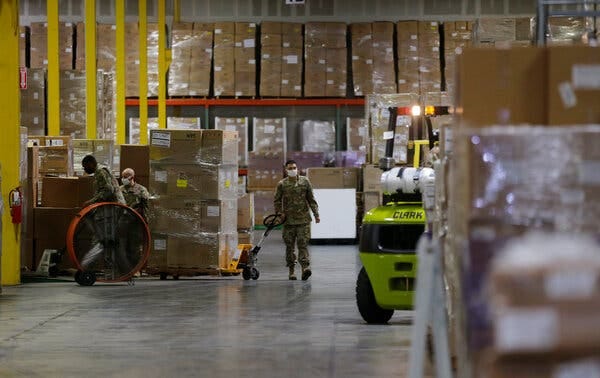
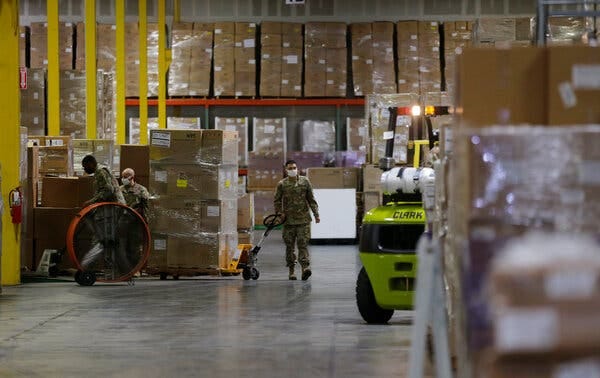
Members of the National Guard at the Texas Division of Emergency Management’s warehouse in San Antonio. The military has worked behind the scenes to bring a virus vaccine to the public.Credit…Eric Gay/Associated Press
When President Trump talks about efforts to deliver the coronavirus vaccine to millions of Americans eager to return to their normal lives, he often says he is “counting on the military” to get it done.
Mr. Trump has given the impression that troops would be packing up vials, transporting them from factories to pharmacies and perhaps even administering shots. And, at times, military officers working on the sprawling interagency program to move those vaccine doses from drug companies into doctors’ offices have indicated the same thing.
In reality, the role of the military has been less public and more pervasive than this characterization suggests.
When companies have lacked the physical spaces needed to conduct their drug trials, the Defense Department has acquired trailers and permits to create pop-up medical sites in parking lots. When a required piece of plastic or glass was in short supply, the military leveraged a law passed during the Korean War to force manufacturers to move them to the front of the line. Should a hurricane hit somewhere, blocking trucks, the military has transportation ready.
But the distribution of vaccines will be left largely to their producers and commercial transportation companies. Black Hawk helicopters will not be landing next to neighborhood drugstore to drop off doses.
Scores of Defense Department employees are laced through the government offices involved in the effort, making up a large portion of the federal personnel devoted to the effort. Those numbers have led some current and former officials at the Centers for Disease Control and Prevention to privately grumble that the military’s role in Operation Warp Speed was too large for a task that is, at its core, a public health campaign.
“Frankly, it has been breathtaking to watch,” said Paul Ostrowski, a retired Army lieutenant general and the director of supply, production and distribution for Operation Warp Speed.
MILITARY ROLE
Read more about the Department of Defense’s role in distributing a coronavirus vaccine.
ADVERTISEMENT
Continue reading the main story
The virus won’t stop evolving when a vaccine arrives.


A colorized scanning electron micrograph of an apoptotic cell (green) heavily infected with coronavirus particles (purple).Credit…NIAID
With the emergence of what seem so far to be safe and effective coronavirus vaccine candidates, it appears that humanity may be the winner once again in the unending evolutionary competition between viruses and people.
But vaccines do not stop the process of evolution. David A. Kennedy and Andrew F. Read of The Pennsylvania State University, specialists in viral resistance to vaccines, wrote in PLoS Biology recently that there is always the chance that any virus can evolve resistance to a vaccine. As vaccines are tested and come into use during the pandemic, they urge monitoring of how the coronavirus responds, just in case.
“Nothing that we’re saying is suggesting that we slow down development of vaccines,” Dr. Kennedy said. And resistance evolves over time, after vaccines come into use, so the authors are not raising any concerns about the safety or efficacy of any current vaccine candidates.
A concern about resistance caused Denmark to call for a cull of all its farmed mink because a mutation in infected mink that had been passed on to people seemed worrisome, although these worries have eased.
One mutation found so far seems to help the virus spread, but does not make it resistant to vaccines or make people sicker.
Researchers at the University of Pittsburgh discovered another mutation in the virus of a kind that hadn’t been seen in coronaviruses before that suggests that the coronavirus may have the potential to develop vaccine resistance. They are currently studying that mutation to learn more. That study was posted online but has not yet appeared in a peer-reviewed journal.
VIRUS SCIENCE
Read more about how scientists think the coronavirus could evolve.

Coronavirus Vaccine Tracker
A look at all the vaccines that have reached trials in humans.
— James Gorman and Carl Zimmer
‘We must learn from the summer’: Europe seeks to avoid mistakes as countries ease restrictions.
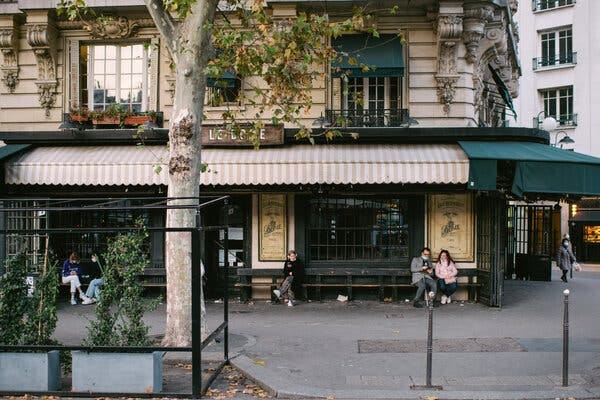

A restaurant in Paris this week that was closed under France’s national lockdown. The country will begin loosening restrictions starting Saturday.Credit…Dmitry Kostyukov for The New York Times
As Americans spent a holiday torn between hope and heartbreak — with the promise of coronavirus vaccines competing with the reality of empty seats around the Thanksgiving table — European nations planned to emerge from lockdowns while still struggling to contain the virus in the weeks before Christmas.
It has been a month since most countries in Europe tightened restrictions to try to get a resurgent virus under control, and while the economic and emotional costs are high, the logic of lockdowns is simple: The tighter the restrictions, the more success in stopping new infections. Caseloads have fallen in Britain, France, Spain and other European countries.
“We must learn from the summer and not repeat the same mistakes,” Ursula von der Leyen, the president of the European Union’s executive arm, told lawmakers in Brussels this week. “Relaxing too fast and too much is a risk for a third wave after Christmas.”
No country has figured out the perfect balance, and even nations that won praise for their handling of the virus have struggled to contain a second wave.
Germany passed one million total infections on Friday, and the country’s daily death toll climbed above 400 for the first time this week. So Germany is tightening the reins.
Spain, which had eased restrictions in June, added new ones in September and later in several regions, including the capital region of Madrid, ahead of a long holiday weekend in early December. No one will be allowed to travel outside their region of residency except for essential reasons between Dec. 4 and Dec. 14.
France, however, is moving toward easing up after imposing stringent restrictions at the end of October, after which the number of new cases plummeted.
“The peak of the second wave of the epidemic has passed,” President Emmanuel Macron of France said this week. He outlined a three-step plan to ease restrictions, starting on Saturday, when small businesses would be allowed to reopen and places of worship permitted to hold services for up to 30 people.
In two weeks, if new cases remain low, museums, cinemas and theaters in France will be allowed to reopen, and people will be permitted to travel to spend Christmas with family.
“But I call upon your sense of responsibility: This will certainly not be a Christmas like the others,” Mr. Macron said.
Under the French plan, restaurants, bars and gyms will be the last to reopen, on Jan. 20.
Prime Minister Boris Johnson of Britain has opted for a “tiered system” in England, with different regions facing different restrictions when the country emerges from its tough national lockdown next week.
But even before the country’s lawmakers vote on the measures, the government faced criticism that the “tiers” were really just another word for localized lockdowns.
More than 23 million people in England will be placed under the tightest restrictions. Another 32 million will fall under the second of the three tiers, and just 1 percent of the population will fall under the least restrictive tier.
— Marc Santora and Raphael Minder
Austria is to begin what will be the largest mass testing program in Europe so far.
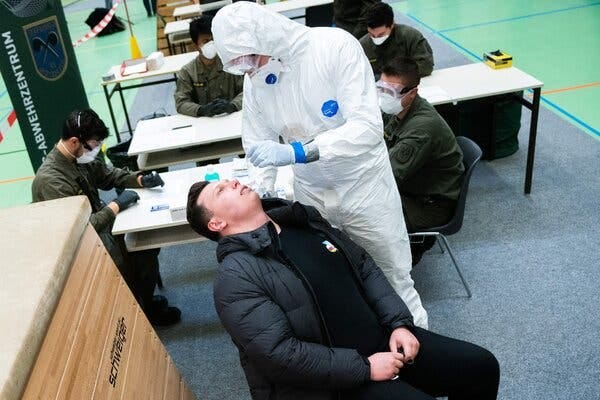

A doctor performing a Covid-19 test in Korneuberg, Austria on Friday. The Austrian military will help test as many as 150,000 residents per day under the country’s new mass testing program. Credit…Georg Hochmuth/Agence France-Presse — Getty Images
In what promises to be the largest mass testing for the coronavirus in Europe to date, Austria will begin systematically testing its population next week.
Following the lead of Slovakia and the Italian province of South Tyrol, Austria hopes that after bringing new infections under control through restrictions on movement and business, the testing will now allow it to better stop outbreaks before they become unmanageable.
“It provides an opportunity to localize a high number of infected people,” Chancellor Sebastian Kurz told journalists last week, on the day that he announced the government had bought enough rapid antigen tests for the entire population. “So that one can break infection chains.”
Britain has also used mass testing, in Liverpool, where a total of around 200,000 people have been tested and around 1000 cases detected. According to the U.K.’s health secretary, Matt Hancock, the project helped reduce the spread of the disease and when England’s national lockdown ends on Dec. 2, Liverpool will avoid the toughest set of coronavirus restrictions the government intends to apply in the country.
As the second wave of the virus swept across the country this fall, health authorities had lost the ability to trace a majority of the new infections.
Despite one of the strictest lockdowns in Europe — during which Austrians are not allowed to leave their dwellings except for essential reasons, schools remain closed and only supermarkets, pharmacies, banks and post offices are open — the country still has one of the highest infection rates in Europe.
As the extreme restrictions start to show results and the government considers easing some of the measures, officials hope wide-scale testing will help provide a way forward in the central European nation of nearly nine million people.
Starting next week, Vienna, and two western states, Vorarlberg and Tyrol, will start testing. Supported by the national army, firefighters and local authorities, testing centers will be set up in congress centers, community halls and other large spaces. The three big centers in Vienna are expected to test 150,000 people daily.
By Christmas the entire country is expected to have completed the first round of testing.
Those who test positive will have to go into isolation and might be retested, a government spokesman said on Friday.
Unlike the mass test in Slovakia, where those who did not get tested were threatened with home isolation, the tests in Austria are voluntary. Last week Mr. Kurz said he believed as many as half of the country’s population of 8.6 million would get tested. The government has secured more than 7 million tests.
“I see it as an essential step to bridge the time until a vaccine is available,” said Mr. Kurz.
ADVERTISEMENT
Continue reading the main story
India begins planning for a vaccine rollout strategy.


A crowded market in Mumbai, India, before the Hindu festival of Diwali this month.Credit…Rajanish Kakade/Associated Press
Prime Minister Narendra Modi of India this week asked regional governments to start setting up coronavirus vaccine distribution systems, a step toward tackling the logistical hurdles in vaccinating the country’s more than one billion people.
The first phase of India’s vaccine rollout plan, in which 250 million Indians will be vaccinated, could cost more than $10 billion, according to the Drugs Controller General of India. Mr. Modi said that he was not certain when the rollout would start and cautioned that the vaccine could cause side effects.
There are five vaccines in clinical trials in India, including a late-stage trial of the AstraZeneca vaccine, which the Serum Institute of India, the world’s largest vaccine maker, is conducting. Serum’s chief executive, Adar Poonawalla, said this week his company would prioritize vaccine supply to Indians over other countries, and that Serum would likely begin marketing vaccines in the first three months of next year.
While India’s new case numbers have dropped in recent weeks, the capital, New Delhi, is experiencing a sharp rise.
The Indian economy has shrunk faster than any other major nation’s, with unemployment already at a four-decade high. Fatigued by lockdown measures, people have flouted virus restrictions, causing the number of cases to climb.
After this month’s Hindu festival of Diwali, officials in New Delhi anticipate a surge in cases in early December and have threatened to shut down markets and limit the number of guests at weddings.
India’s Economy Shrinks Sharply as Covid-19 Slams Small Businesses

Just before pulling the U.S. out of the W.H.O., Trump demanded major changes to its pandemic response.
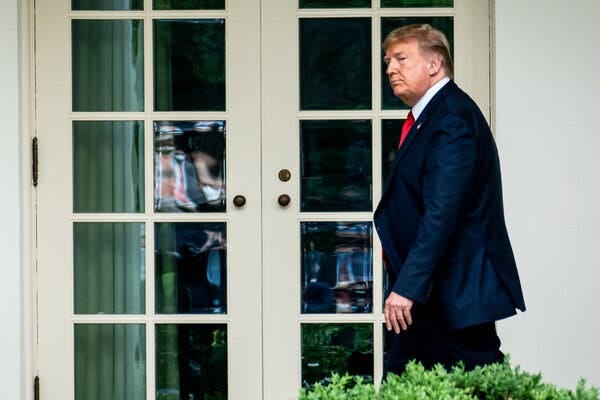

President Trump returning to the Oval Office after announcing the United States would leave the W.H.O. at a news conference on May 29. Credit…Erin Schaff/The New York Times
GENEVA — In late May, the American ambassador in Geneva, Andrew Bremberg, went on a rescue mission to the World Health Organization headquarters. He told its director general, Tedros Adhanom Ghebreyesus, that despite weeks of threats that President Trump would quit the health organization over his frustrations about the organization’s dealings with China on the pandemic, the relationship could still be salvaged.
Mr. Bremberg hand-delivered a list of seven demands that American officials saw as the beginning of discreet discussions.
Hours later, Mr. Trump took the lectern outside the White House and blew it all up, announcing that the United States would leave the W.H.O. The announcement blindsided his own diplomats and Dr. Tedros alike.
The W.H.O. leader refused to make concessions or counteroffers, according to American and Western officials. And Mr. Trump ultimately made good on his promise to abandon a health agency that the United States helped form a half-century ago.
The final list emerged from discussions between the White House, State Department and the Department of Health and Human Services. In Geneva, Mr. Bremberg consulted with European allies, who were eager to keep Mr. Trump from abandoning the health organization, Western diplomats said.
By late May, the list stood at seven items. Six were focused on the pandemic, with touches of Trump administration politics sprinkled throughout:
- The W.H.O. should investigate the handling of the outbreak and the source of the virus.
- Dr. Tedros should call on China to provide live virus samples and stop censoring Chinese doctors or journalists. This would have been a significant break for the W.H.O., which rarely criticizes members.
- Dr. Tedros should say that countries were right to consider travel restrictions during the pandemic — a break from the longstanding advice that limiting travel would not slow the virus but would harm economies and delay medical treatment. This risked dragging the W.H.O. into the presidential campaign, as Mr. Trump had made travel restrictions a rallying cry. Ceding to the demand could also have been seen as allowing the United States to strong-arm health policy.
- The W.H.O. should dispatch a team to Taiwan to study its successful pandemic response. Beijing, which claims the self-ruled island as its own, exerts tremendous pressure to keep the W.H.O. from engaging with Taiwan’s government.
- The W.H.O. should pre-qualify coronavirus drugs and vaccines for use around the world, once they were authorized by major regulators in the United States, Canada, Europe or Japan.
The final demand was that Dr. Tedros should ensure that countries like the United States that contribute heavily to the W.H.O. are proportionally represented on the organization’s staff.
— Matt Apuzzo, Noah Weiland and Selam Gebrekidan
DEMANDS ON THE W.H.O.
Read the full article on the demands the Trump administration made of the World Health Organization just before leaving it .
People are snagging Black Friday travel deals for a post-vaccine world.


Hurtigruten’s Nordnorge ship in Trondheim, Norway, last February. The cruise line is booking trips into 2022 at deep discounts.Credit…Ntb Scanpix/via Reuters
Black Friday deals in the travel industry are bigger, better and longer this year, as operators seek to kick-start travel planning in the wake of promising coronavirus vaccine news. Most sale terms acknowledge the inevitable disruptions wrought by the pandemic with flexible cancellation policies and some even throw in travel insurance that will cover your treatment if you are diagnosed with Covid-19 while traveling.
Experts advise holding off on any deals in the next few months, because discounts may get even better as hotel stays, cruises and airline bookings remain depressed. But deals on the far horizon, when vaccines may be widely available, are a more enticing gamble.
“If you can get those reservations with full flexibility, that might be a free option you want because I would expect a big uptick in demand,” said Christopher Anderson, a professor of operations management in Cornell University’s hotel school.
Early on, sales seem to be trending to far horizons. Hurtigruten, the Norway-based expedition cruise line, said half of its Black Friday sales, running until Wednesday, were for itineraries in 2022. G Adventures, a small group tour company with Black Friday deals through Nov. 30, said most of its sale bookings are for June through October of next year.
Many sales are yet to start, including up to 70 percent off more than 1,000 tours worldwide at TourRadar, an online agency.
“We’re a little nervous about how it will do, but hopefully the vaccine news drums up some interest for tours later in 2021,” said Cameron Papp, a spokesman for TourRadar.
— Elaine Glusac
BLACK FRIDAY, LIVE
Read our full coverage of a Black Friday like no other.
ADVERTISEMENT
Continue reading the main story
The coronavirus is upending Thanksgiving week for many college football teams.


The Ohio State Buckeyes pulled out a win over a strong Indiana team last weekend, but the team will pass on some traditional season-ending rites as they guard against the coronavirus.Credit…Joseph Maiorana/USA Today Sports, via Reuters
College football players across the United States are accustomed to playing and practicing through Thanksgiving weekend, but the surging coronavirus is forcing some teams to make changes large and small to their well-honed routines.
At Colorado, for example, the group holiday meal for football players, a ritual since at least the mid-1990s, will not happen. The team has dispensed with all communal meals this year.
“Everything has been grab-and-go, even on the one road trip,” said David Plati, an associate athletic director at Colorado.
The New York Times contacted all 65 football programs in the Power 5 conferences to ask how they were handling Thanksgiving this season. Of the 47 that responded, most said they would treat this week like any other in the virus-infected season.
Players on the University of Illinois football team, which will host the fourth-ranked Ohio State Buckeyes on Saturday, will be tested for the virus between 6 a.m. and 7 a.m. on Thursday, practice at 8 a.m. and have a team Thanksgiving meal at 11 a.m., according to Kent Brown, an associate athletic director.
“The schedule isn’t much different than past seasons, although players were able to leave campus to gather for Thanksgiving at a local team member or coach’s house for Thanksgiving before reporting back Friday morning,” Brown said. “But in the past, players never had to test for Covid every morning.”
At Ohio State, adapting to the coronavirus pandemic means postponing a beloved rite. The Buckeyes typically have their final regular-season practice on the morning of the holiday. The practice usually concludes with Senior Tackle, when each senior addresses the team and then hits a blocking sled or tackling dummy one final time.
Afterward, players who live near the Columbus campus often take some teammates home for Thanksgiving, while others will have their own families in town or go to a coach’s house.
“This year, however, no one will be going home for Thanksgiving and the team will dine together on Thursday,” Jerry Emig, an associate athletic director, wrote in an email. “Senior Tackle won’t take place until later. We fly to Illinois Friday afternoon.”
— Alan Blinder and Kevin Draper
N.F.L. CLUSTER
Quarterback Lamar Jackson, pro football’s reigning M.V.P., is the highest-profile player to be caught up in the Baltimore Ravens’ outbreak.
‘Remain home and stay on the good list,’ say N.Y.C. SantaCon organizers.


A bar crowded with SantaCon revelers last year. Credit…Eduardo Munoz/Reuters
New York City streets will officially be devoid of throngs of the jolliest — and perhaps most inebriated — St. Nicks this year. SantaCon, the daylong bar-crawling event that some people love, and many love to hate, has been canceled.
“All of the reindeer got the ’rona so, the elves have advised Santa to hold off the in-person merriment,” SantaCon’s organizers wrote on their website. “Remain home and stay on the good list.”
SantaCon came to New York City in 1997, having already hit Portland and Seattle. Revelers usually dress up as Santa, elves or reindeer, sometimes making their own holiday-related costumes, and cram 12 days of Christmas boozing into one. The event brings troves of visitors from the tristate area, and plenty of eye rolls from nonparticipating New Yorkers.
This year’s festivities were called off the same day that Gov. Andrew M. Cuomo of New York announced a plan to combat the coronavirus during the winter season and warned that the holidays will be telling of the state’s recovery.
On the SantaCon website, the countdown was adjusted forward to the 2021 date. As of Friday, there were 349 days to go.
Comments
Post a Comment